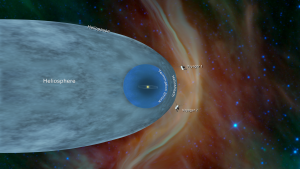
Public domain (https://photojournal.jpl.nasa.gov/figures/PIA22835_fig1.png)
Voyager 2, a deep-space probe launched by NASA, has reached interstellar space, following Voyager 1, which left “the region of space outside the bubble-shaped boundary produced by wind streaming outward from the sun” in 2012. Both probes were launched in 1977, but had different routes.
The probe reached interstellar space just over a year ago, but the findings have only recently been reported on. Researchers at the University of Iowa included a plasma wave instrument on Voyager 2, and thus were able to identify the moment when the probe passed out of interstellar space based on a shift in the plasma density, which Voyager 1 also experienced.
The location at which the two probes reached this point also helps scientists visualize the shape of the heliosphere as somewhat bullet shaped, as pictured, and generally symmetrical, which provides new information about the heliosphere and other components.
You can read more about their findings here!
Follow us online: